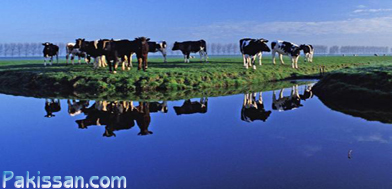|
Our dairy sector
By Dr Sania Chaudhry

The entire public sector of Pakistan is affected by the
incompetence and bad governance of successive regimes.
Primarily an agrarian country with over 70 percent
population residing in the rural areas, the agricultural
sector is one of the most neglected areas of Pakistan’s
economy. Despite the fact that almost all civilian
governments in Pakistan have had a significant presence of
feudals and mega landlords, both as legislators and
ministers, there has been little development in the sector.
As
compared to the manufacturing industry, the
agricultural sector is a relatively slow moving
business area that focuses on long-term
productivity and results. Investors generally
tend to be attracted to businesses that can reap
quick profits. As a result, there is little
self-based initiative by the modern investor to
venture into this area. Concurrently, the public
sector has also neglected, mismanaged and
mishandled the agricultural industry. Acco-
rdingly, when compared to international
standards, Pakistan is far behind in yield per
acre, in milk and meat yield per animal.
Needless to say, the agricultural sector has a
significant contribution in Pakistan’s economy.
Pakistan is considered the fourth-largest milk
producing nation in the world. Twenty-three
percent of the gross domestic product (GDP)
comes from this sector, 51 percent of which is
attributed to the livestock sector. The
contribution to GDP from the livestock sector is
11.4 percent, which is higher than the
contribution made by the entire crops sector
(10.9 percent) of the country. Rs 53 billion
were earned as foreign exchange from livestock
in 2000-2001.
The last decade saw the introduction of imported
cows and buffaloes for mass milk production from
Australia, Europe and the United States. The
role of the various government departments
involved in promoting the import of milking
animals from countries, having a totally
different weather profile than ours, has been
highly controversial with high casualties. There
is a clear-cut lack of policy and assistance for
the indigenous small to medium livestock farmer.
The SMEDA has assumed the role of an importing
agent of foreign cows and buffaloes; hence, it
is accused of neglecting the development of the
indigenous livestock industry. Clients
approaching SMEDA for assistance on starting a
dairy farm are aid to be only encouraged to set
up an imported animal farm and no help is
available to assist in the farming of indigenous
breeds.
The indigenous livestock sector is characterised
by very low milk yield per animal. The dairy
sector mostly operates on non-commercial basis
in the unorganised sector, while the organised
sector processes only a small fraction of the
country’s total milk production. To meet the
domestic demand, Pakistan imports powdered milk.
Average annual deficit of fresh milk is
projected at 1170.41 million litres.The major
milk producing countries in the European Union
(EU) and North America provide regular farm
subsidies to the dairy sector, while none are
offered to the dairy sector in Pakistan. The
fact is that Pakistan enjoys comparative
advantage in milk production, despite its very
low milk yields per animal.
Several years ago, our world renowned Sahiwal
breeds famous for high milk production were
imported by Australians to improve their milk
yield per animal through crossbreeding. Due to
the long productive cycle of these animals, it
takes several years to develop breeds of animals
with high milk yields. The countries with a
long-term vision and policy, thus, opted for
this route, while our reactive approach oriented
governments preferred the shortcut by
encouraging the import of Australian and Swedish
milking animals.
The Australian milking animals yield over 20 to
30 litres per day, while the Swedish animals
yield between 30 to 40 litres per day. Special
controlled sheds are needed to keep the
temperature 5° to 10° below the atmospheric
temperatures of the day. The feed for these
animals is also procured from specific
companies. In addition, specially trained dairy
technicians and managers are needed to run these
farms. Also, the cost of these imported cows and
buffaloes is 2 to 3 times more than the average
price of our domestic animal. Then the setting
up and maintaining of controlled shed dairy
farms is an expensive affair and not advisable
for the small to medium livestock farmer.
To make our livestock and dairy sector efficient
in the long term, we need a balanced policy to
ensure that the small farmer is not adversely
affected by modernising the industry through
practices favouring the rich and the wealthy.
Farmers need to be educated and facilitated
through sustained efforts to improve their
animal stocks, management systems, and
production technologies.
The
writer is a former member of Civil Services of
Pakistan, and change management consultant and a
public sector management analyst.
.
January 29, 2013
Source:The Nation |
|
Pakissan.com;
|